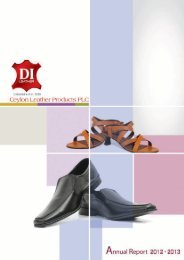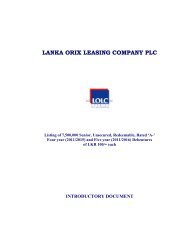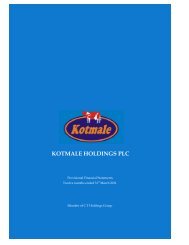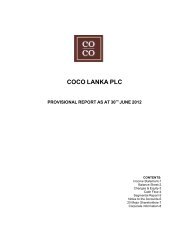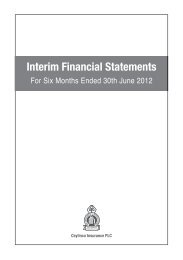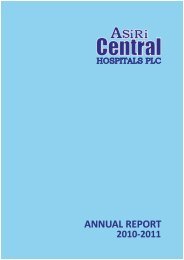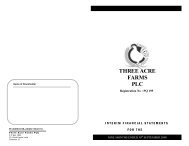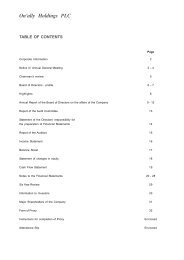Annual Report 2011 - Colombo Stock Exchange
Annual Report 2011 - Colombo Stock Exchange
Annual Report 2011 - Colombo Stock Exchange
- No tags were found...
Create successful ePaper yourself
Turn your PDF publications into a flip-book with our unique Google optimized e-Paper software.
24 <strong>Annual</strong> <strong>Report</strong> <strong>2011</strong>Notes to the Financial StatementsYear ended 31 st December <strong>2011</strong>2. SUMMARY OF SIGNIFICANT ACCOUNTING POLICIES (cont’d)2.1. General Policies (cont’d)2.1.5. Taxation (cont’d)b) Deferred TaxationDeferred taxation is provided using the liability method. The tax effect of all temporary timingdifferences which occur where items are allowed for income tax purposes in a period differentfrom that when they are recognized in financial statements is included in the provision fordeferred taxation (or future income tax benefits as applicable) at current rates of taxation.Deferred tax assets (debits) are recognized for all deductible temporary timing differences andcarried forward unused tax losses to the extent that it is probable that future taxable profitswill be available against which such unused tax losses and deductible temporary timingdifferences can be utilized. Deferred tax assets are reduced to the extent that it is no longerprobable that the related tax benefit will be realized.2.1.6. Borrowing CostsBorrowing costs are recognized as an expense in the period in which they are incurred, except tothe extent where borrowing costs that are directly attributable to the acquisition, construction, orproduction of an asset that takes a substantial period of time to get ready for its intended use of sale,are capitalized as part of that assets.2.1.7. Post Balance Sheet EventsAll material events occurring after the Balance Sheet date are considered and where necessary,adjustments or disclosures have been made in the Financial Statements.2.2. Valuation of Assets and their Measurement Bases2.2.1. InventoriesInventories are valued at the lower of cost and estimated net realizable value, after making dueallowances for obsolete and slow moving items. Net realizable value is the price at which inventoriescan be sold in the normal course of business after allowing for cost of realization and / or cost ofconversion from their existing state to saleable condition.The cost of each category of inventory is determined on the following basis:Food and Beverages - At actual cost of first in first out (FIFO) basis.Housekeeping, Maintenance & Other - At actual cost on first in first out (FIFO) basis.2.2.2. Trade & Other ReceivablesTrade receivables are stated at the amounts they are estimated to realize net of provision for bad anddoubtful receivables.Other receivables and dues from related parties are recognized at cost less provision for bad anddoubtful receivables.2.2.3. Cash & Cash EquivalentsCash and cash equivalents are defined as cash in hand, demand deposits in bank and short termhighly liquid investments, readily convertible to known amounts of cash and subject to insignificantrisk of change in value.For the purpose of Cash Flow Statement, cash and cash equivalents consist of cash in hand anddeposits in banks, net of outstanding bank overdrafts.Interest paid is classified as operating cash flows, interest and dividend received are classified asinvesting cash flows while dividend paid are classified as financing cash flows for the purpose ofpresentation of Cash Flow Statement, reported based on the indirect method.





